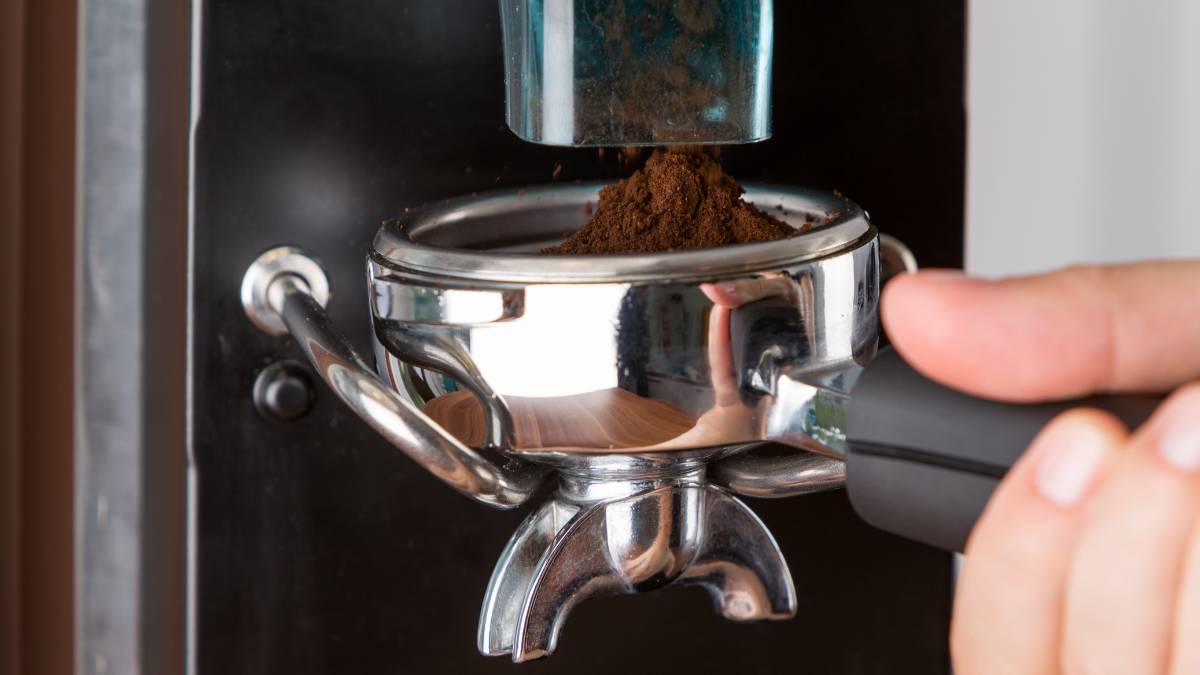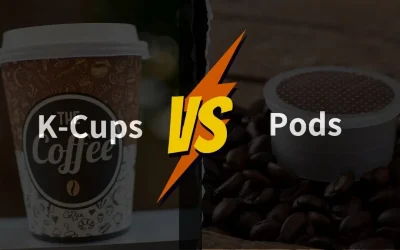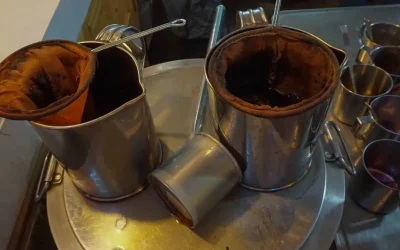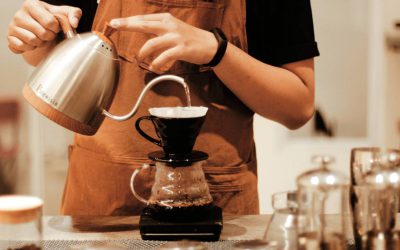Coffee Grinding Basics

The way you grind your coffee (and when you grind) is the first step toward influencing how the final brew tastes. Believe it or not, you can have the highest quality coffee, the perfect roast, pure water, premium filters, and an excellent coffee maker and still ruin it all with an incorrect grind. But don’t let your woes stop you; some basic knowledge about coffee grinding will go a long way toward helping you make that perfect brew.
Regardless of your coffee brewing method, the basic goal of grinding coffee is the same: Break down the roasted coffee bean to expose the interior of the bean allow the right amount of oils and flavors to be extracted. Ground coffee has much more surface area than whole bean coffee, allowing water (the extraction agent) to make contact with more coffee when brewing. More contact means more flavor extraction and better yield.
The main “rules” of coffee grinding are:
1. Grind your coffee right before you are ready to brew
2. Choose the right grind size (fineness/coarseness)
3. Select and use a high quality coffee grinder
4. Keep your coffee grinder clean
Selecting the Right Coffee Grinder
There are basically two types of coffee grinders…
Blade Grinders
Most inexpensive (under $30 or so) grinders use a sharp metal blade to literally chop up your coffee beans. As the blade spins, the coffee beans are chopped. You control the fineness of the grind by “pulsing” the power button until you’re satisfied. It can be difficult to judge how much coffee to grind, and how finely to grind it, however. Another downfall – if you are grinding finely, and therefore leaving the beans in the grinder longer, there can be significant heat created by the blades. This can give your final coffee a burned taste and destroy other flavors. Blade grinders are fine for basic use, but that’s about it.
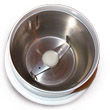
Advantages
- Less Expensive: less than $30 or so
- Easy to Operate: just “pulse” the button
- Easy to Olean: simple design with only one moving part (blade)
- Easy to Store: small size means a small countertop footprint
- Faster: just pop some beans in and go, grinds fast…maybe too fast
Disadvantages
- Grinds Unevenly: some beans will be powdered and some left too large
- Inconsistent: you control grind, so it’s easy to grind too fine or too coarse
- No Portion Control: you have to measure the amount of coffee beans every time
- Overheats Coffee: tends to heat coffee while grinding, adversely affecting flavor
- Less Capable: cannot grind much better than fine (see grind size specs below)
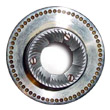
Burr Grinders
Burr grinders crush the beans between a moving grinding wheel and a non-moving surface. Typically, the burr position can be adjusted to regulate the grind size. Because burr grinders grind a few beans at a time, in sequence, they provide a much more even and consistent grind. In the burr category, there are two different types.
Wheel Burr – The less expensive of the two burr grinders. The higher rotation speed of the wheel can make these grinders a little more messy and noisy, however.
Conical Burr – These are the best grinders money can buy. The burr spins slower than the wheel model, which makes them quieter and less messy. Also, conical grinders are less likely to clog when grinding oily or flavored coffee. Conical burr grinders are more expensive, but definitely worth the extra cash.
Advantages
- Grinds Evenly: an even, consistent grind makes for a better cup of coffee
- Broad Grind Adjustments: grinds coarse to fine (some will even do Turkish)
- Preserves Flavor: will not overheat coffee like a blade grinder
Disadvantages
- Louder: many burr grinders tend to be a little noisy
- Slower: burr grinders methodically grind your beans…it’s worth the wait, though
- More Expensive: burr grinders can by pricey, but you get what you pay for
Choosing the Right Grind Size
The ideal fineness (or coarseness) of your ground coffee depends mainly on what type of brewing method you are going to use. In general, if you brew coffee that is ground too coarse, the coffee can be under-extracted (weak), and less flavorful.
If your coffee is ground too fine, however, the coffee can be over-extracted and bitter. Small changes in grind size can drastically affect the taste of your final brew.
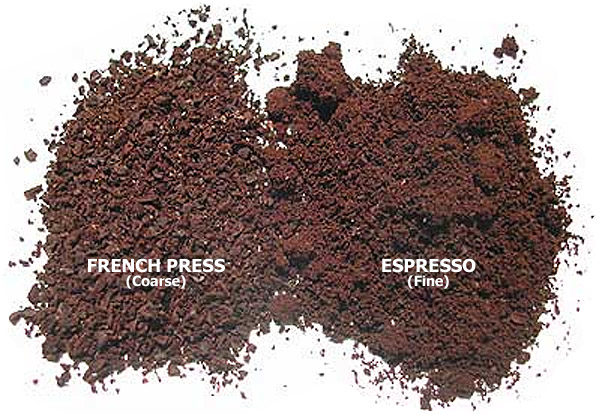
Grind Size Descriptions – How to identify your grind size
- Coarse: Distinct, chunky, pieces of coffee beans. Like heavy kosher salt.
- Medium: Gritty texture with visible flakes. Like very coarse sand.
- Fine: Much smoother texture. Like table salt, maybe a little finer.
- Extra Fine: Coffee grains still barely discernable. Finer than granular sugar.
- Turkish: Powdered with no grains. Blade grinders cannot grind this fine. Like flour.
Grind Size vs. Brewing Method Chart – How to select the right grind size
| Grind Size | Ideal Brewing Method |
| Coarse | Plunger Pot French Press Percolator Vacuum coffee pot |
| Medium | Drip coffee makers with flat bottom filters (BUNN, Bloomfield, etc.) |
| Fine | Drip coffee makers with cone shaped filters (KRUPS, Cusinart, etc.) Espresso moka pots |
| Extra Fine | Espresso machines – pump Espresso machines – steam |
| Turkish | Ibik |
How to Make More Flavorful Coffee
Achieving a more flavorful cup of coffee involves several key factors beyond just grinding beans. Here are some tips to enhance the taste and aroma of your coffee:
1. Use Fresh, High-Quality Coffee Beans
Freshness is essential to flavor. Coffee beans start losing their flavor shortly after roasting. For the best taste, choose high-quality beans and grind them just before brewing. Specialty coffee from reputable roasters often has more complex and richer flavors compared to mass-produced beans.
2. Grind Coffee to the Right Size
The grind size significantly impacts flavor extraction. Adjust the grind size according to your brewing method:
- Coarse Grind: Best for French press or cold brew to prevent over-extraction and bitterness.
- Medium Grind: Ideal for drip coffee makers or pour-over methods.
- Fine Grind: Works well with espresso machines, creating a rich, intense flavor. Grinding too fine for certain methods can lead to bitterness, while too coarse can result in weak, under-extracted coffee.
3. Use Fresh, Filtered Water
Since coffee is mostly water, the water quality directly affects flavor. Use fresh, filtered water to avoid impurities that could alter the taste. For optimal results, aim for water with a pH around 7 and avoid distilled or overly soft water, as these can result in flat flavors.
4. Experiment with Coffee-to-Water Ratios
The coffee-to-water ratio influences strength and flavor balance. As a general rule:
- 1:15 to 1:17 ratio (1 gram of coffee per 15-17 grams of water) is ideal for most drip and pour-over methods.
- For espresso, aim for a 1:2 ratio to produce a richer, more concentrated flavor. Adjusting the ratio allows you to tailor the coffee’s strength and bring out desired flavor notes.
5. Control Water Temperature
Water temperature affects the extraction process and flavor outcome. The optimal brewing temperature is between 195°F and 205°F (90°C – 96°C). Too hot, and you risk over-extraction and bitterness; too cool, and the coffee may taste weak and sour.
6. Store Coffee Properly
Oxygen, moisture, heat, and light all degrade coffee flavor. Keep beans in an airtight container, in a cool, dark place, and avoid storing them in the fridge or freezer, as this can introduce moisture. Storing beans properly helps maintain freshness and flavor longer.
7. Experiment with Brew Methods
Different brewing methods bring out unique flavors in coffee:
- Pour-Over: Highlights subtle, complex notes.
- French Press: Extracts robust, full-bodied flavor.
- Espresso: Delivers a concentrated, rich taste. Experimenting with various methods can help you find the one that best suits your taste preferences.
8. Pre-Infuse Your Coffee Grounds (Blooming)
For methods like pour-over or drip, consider pre-infusing or “blooming” the coffee by pouring a small amount of hot water over the grounds and letting it sit for 30 seconds. This releases trapped carbon dioxide, allowing the coffee to “bloom” and enhancing the extraction of flavors in the brew.
9. Use Freshly Ground Spices or Flavored Additions
For those who enjoy flavored coffee, consider adding freshly ground spices such as cinnamon, nutmeg, or cardamom directly to the grounds. This can add depth and warmth to your coffee without overpowering it. Alternatively, experiment with a pinch of sea salt to reduce bitterness and enhance sweetness.
By combining these methods, you’ll create a more flavorful coffee that is tailored to your taste, whether you prefer a bright, fruity profile or a deep, robust richness.

